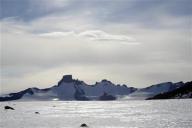East Antarctic ice began to melt faster in 2006

By Nina Chestney
LONDON (Reuters) - East Antarctica's ice started to melt faster from 2006, which could cause sea levels to rise sooner than anticipated, according to a study by scientists at the University of Texas.
In the study published in Nature's Geoscience journal, scientists estimated that East Antarctica has been losing ice mass at an average rate of 5 to 109 gigatonnes per year from April 2002 to January 2009, but the rate speeded up from 2006.
The melt rate after 2006 could be even higher, the scientists said.
"The key result is that appear to start seeing a large amount of ice loss in East Antarctica, mostly in the long coastal regions (in Wilkes Land and Victoria Land), since 2006," Jianli Chen at the university's center for space research and one of the study's authors, told Reuters.
"This, if confirmed, could indicate a state change of East Antarctica, which could pose a large impact on global sea levels in the future," Chen said.
Previous estimates for East Antarctica projected anywhere between a 4 gigatonne per year loss and a 22 gigatonne per year gain, according to the report.
The full study is available at www.nature.com/ngeo.
Climate change is turning Antarctica's ice into the one of the biggest risks for coming centuries. Even slight melting could drive up sea levels and could affect world's cities.
Rising temperatures are thought to be the main cause of melting ice, and world leaders are under pressure to agree on a new climate treaty at an upcoming U.N. summit in Copenhagen to curb global warming.
MELTDOWN
The scientists used satellite observations of gravity change over the period April 2002 to January 2009 to calculate the rate of the ice loss in East Antarctica's coastal regions.
The ice sheet's mass has long been difficult to estimate.
"At various times, estimates have disagreed on the sign of the mass balance, as well as its magnitude," the report said.
The whole Antarctic region could be losing ice at a rate of 113-267 gigatonnes a year, with 106-158 gigatonnes coming from West Antarctica, the scientists estimate.
A separate study on Thursday found that melting ice from Greenland and Antarctica will lead to a much sharper rise in sea levels than previously thought.
Climate change will cause a rise of at least 1 meter in sea levels by the end of this century, according to a review of scientific data by environmental group Clean Air-Cool Planet.
The projection is in sharp contrast to a 2007 study by the U.N.'s Intergovernmental Panel on Climate Change, which said world sea levels could increase 18-59 centimeters by 2100.
(Reporting by Nina Chestney; Editing by Angus MacSwan)
© Thomson Reuters 2009 All rights reserved
